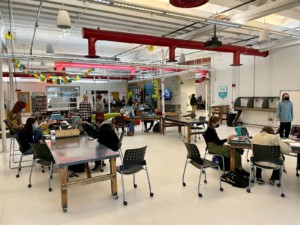Coherence = f(Sustained Leadership)
Summit Preparatory High School is a very good school, one of the best I’ve visited. You may recall seeing it featured in Superman. Quality is a result of vision and sustained commitment over a decade. The level of coherence—the degree to which every aspect of the school works together for students and teachers—is very high.
Some key aspects that appear to be well designed and aligned:
1) rigorous college prep core curriculum
2) a long day and year with two intersessions
3) advisory curriculum and structure that prepares every student for college
40 days of high quality professional development
4) career lattice and differentiated compensation system
It would very difficult to create level of coherence observed at Summit as a traditional public school—and impossible to sustain.
Rather than a board recruited to support its mission, a district school would have spent the last decade fighting for autonomy. District impositions (PD, information systems, schedules, transportation) would usually be orthogonal to coherence.
A few districts, like Bellevue WA, created elaborate district wide instructional systems. They last as long as one superintendent is around and then get relaxed or replaced. Implementation effectiveness (in a really good district like Bellevue) is probably 60% rather than 100% at Summit.
The ability to create and sustain a coherent school model with systems that ensure consistently high execution are a key advantage of charter management organizations.
Ganas: from middle school failure to college graduation
Tears were flowing on Tuesday morning. The few seniors that had not met all of the graduation requirements were making a case for an exception and constructing next steps with a panel of staff members. The bar is set very high: not only does every student need to successfully complete a rigorous college prep curriculum, every student must be accepted into a four year university in order to graduate.
Downtown College Prep (DCP) in San Jose is a high school that goes out of its way to find students that were not successful in middle school. Most students are Latino, from low income families, and substantially behind when they come to DCP. They all leave prepared for and accepted to a four year university. They do it the old fashion way—relationships and hard work.
Teachers are there because they believe in the mission and support the culture: ganas, comunidad, orgullo (desire, community, and pride). The whole staff advises a group of about 22 students for the four years they are on campus. They get some help from Naviance.
Like Summit Prep, DCP has developed smart people systems. A sophisticated hiring process screens a big pool of applicants and invites a qualified few to teach a lesson—not a favorite but the next lesson in a defined sequence for a specific group of students. Once hired, a rigorous staff evaluation process is accompanied by quarterly staff surveys and 360 degree evaluations of school leaders.
Have you heard some cranks say that small schools were a failed fad? Anyone that says small schools didn’t work just doesn’t get out much. Every developer of high quality schools in the U.S. still uses the 100 kids per grade rule of thumb. A delegation from Washington State visited KIPP, Aspire, Summit, Rocketship, and DCP schools this week. They saw schools that follow the formula.
It’s interesting to note that they are all introducing blended learning models in September spurred on by catastrophic California budget cuts. The personalizing potential of online learning and budget pressures will cause all these chains to experiment with slightly larger schools. Any negatives a a slight increase in size are expected to be offset by the benefits of personal digital learning technology.
DCP and charter schools like it are changing lives. Maybe five or six out of a hundred poor kids from downtown San Jose finish college. DCP grads finish college at 10 times that rate—that’s an order of magnitude improvement in expected life outcomes.
As I’ve said for a decade, small school are no panacea—necessary but insufficient determinants of quality—they just give you a shot at getting to know a group of kids and creating an intentional culture. As we invent new ways to customize learning and build community (online and onsite), we’ll invent new school formats and invent new rules of thumb. As my friends at Big Picture taught me, rigor, relevance, and relationships are likely to be key to academic success with teenagers for a long time.







0 Comments
Leave a Comment
Your email address will not be published. All fields are required.